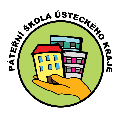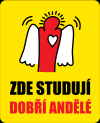Gymnazium dr. Vaclava Smejkala, Usti nad Labem, Czech Republic (in English)
School characteristics
The grammar school was opened in 1989. It is situated in the housing estate Severní Terasa which provides quiet environment. The school educates pupils in eleven 8-year classes and in ten 4-year classes. More than 600 pupils attend the school every year and they can study either for four or eight years.
School equipment
Every class has its own "home classroom". Apart from them there are three computer classrooms, specialised science, language, arts and music classrooms.
There are also two multimedia classrooms, one library, two gyms.
We can find there also offices for about fifty teachers.
Every pupil in the school has their own locker. Pupils can spend their breaks in a dayroom.
School canteen
Students can have a meal in the school canteen which is situated in the school building. They can choose from two meals. There is no fast food offered in the canteen as in other countries. The meal consists of a soup, a main dish and a drink. The school canteen has the capacity of 500 pupils. Those who still prefer fast food can help themselves with baguettes, cookies and cold or hot drinks from vending machines.
4-year curriculum
Begins after finishing primary school, at the age of 15, and lasts four years.
8-year curriculum
Begins after the fifth grade of primary school, at the age of 11, and lasts eight years.
There is a final exam called maturita after finishing each of them. It consists of two compulsory (Czech and foreign language) and two optional subjects.
Handicapped students
Our school has a non-barrier access to the school building, which enables handicapped students in wheelchairs to study at grammar school.
Important details
Official name:
Gymnázium dr. Václava Šmejkala, Ústí nad Labem, Stavbařů 5, příspěvková organizace
[Grammar school of dr. Václav Šmejkal, Ústí nad Labem, Stavbařů 5, contributory organization]
Post address:
Gymnázium dr. Václava Šmejkala
Stavbařů 5
400 11 Ústí nad Labem
E-mail address:
Website:
Phone numbers:
+420 472 772 022
+420 472 772 021 (Fax)
School administration:
Headmaster:
Mgr. Michal Šidák (reditel@gym-ul.cz)
History of grammar schools in Ústí nad Labem
The first Czech Grammar School in Ústí nad Labem was set up in 1893. Classes started in its own building , designed by Josef Gočár, on 5th September 1926. In 1938 there were 450 students.
Between WWI and WWII the Czech Grammar School was renamed to the German Grammar School because of the Protectorate of Bohemia and Moravia. It existed here up to 1945. After the Liberation in 1945 the Czech Grammar School was re-opened.
In 1989 another grammar school was established in Ústi nad Labem. It is located in the building of the former Secondary Pedagogical Training School in the district of Severní Terasa. On 1st September 2006 this school was renamed in honour of Dr. Václav Šmejkal. And that's our school.
Dr. Václav Šmejkal
Dr. Václav Šmejkal, who gave the name to our school, was a teacher first. Then he became the headmaster at Grammar School. He worked as a coordinator of cultural activities in Ústí nad Labem too.
After 1948 he became a victim of communist terror. One of his students showed him an anticommunist pamphlet, but Mr. Šmejkal considered it immoral to hand it over to the police. Later on, because of this, he was sentenced to nine years in prison. After his release he wasn't allowed to teach or to do any social activities.
Nevertheless, he didn't feel bitter, he was always keen on studying and travelling around his home country.
He was rehabilitated in March 1969.
Cooperation with parents and pupil projects
Since 1st January 2006 there has been a school council, which has 6 members. It is an important partner of the school executive and helps to run the school.
The students' parliament, in which there are representatives of each class, has a long tradition.
The school magazine TlachaPost is one of the students' activities. The editorship of the magazine was formed in 1999. The name they chose for the magazine was a compromise - the word Post should hint at the serious meaning of the magazine, and the word Tlacha, which originates in the word Tlachal, should hint at the funny side of the magazine. The contents of the magazine are serious articles, interviews, important information, funny stories, essays and questionnaires.
Other students' activities are Radio Kotelna and TVs5 broadcasting.
The pride of the school is the choir named Gauneramus lead by Mr. Vladimír Saska. It was formed in September 2003 and became popular at the music scene of Ústí. It regularly organises summer and Christmas concerts. The choir is very successful in national and international contests, for example the festival Summer of Hvar in Croatia.
Every year the school organises the Open House for people interested in studying there.
Parents meet with teachers twice a year to consult school results of their children.
Long term projects, international cooperation
Since 2005 our school has been involved in the EU project Socrates- Comenius under the slogan: "The human voice and body are the best musical instruments". The other participants of the project are: Liceo Polivalente Cisternino (Italy) and Skóla Podstawowa Sienmanovice - Katovice (Poland).
Every year, we organize exchange stays of students from Germany (Chemnitz), Switzerland (Lausanne) and France (Moulins). Regularly, we organize trips to Great Britain and Ireland and ski training courses in Austria or in Italy.
Students of our school has visited Japan (Hiroshima) two times.
Students also meet young reporters from Bad Marienberg, Germany regularly.
In 2005/2006 we attended a few seminars about the co-existence of the EU states, anti-fascism and tolerance, in our partner town Chemnitz.
We also organized a seminar about the topic "We are in the EU" for students of the grammar school in Chemnitz.
We are successful in sports (volleyball, basketball) at both national and international levels.
Since 2001 students have had an opportunity to do examination tests for the German language diploma of the 2nd grade. Holders of the diploma are accepted by universities within the EU without any further language examination.
Students are also prepared for the FCE exam.
History of Ústí nad Labem
Ústí nad Labem is situated at the confluence of the rivers Elbe and Bílina not far from the German border. It is an important junction and an industrial centre that is still developing owing to the chemical and food processing industries. Our town is the seat of Jan Evangelista Purkyně University which was named after a famous Czech biologist.
The region of Ústí n. L. is one of the oldest inhabited parts in the Czech Republic. From the early Middle Ages Ústí was a place where important events took place. During the rule of Václav I, around 1240, Ústí became a royal town. At the beginning of the 16th century Ústí started to develop really fast. This development was partially stopped in the 17th and 18th centuries due to war conflicts, especially during the Thirty Years' War. In the 19th century Ústí experienced an industrial boom during the rule of Franc Josef I. In the 1930's Ústí faced the growth of Nazism spreading from Germany. During the air raids at the end of WWII Ústí was badly damaged. Since then the church tower has been almost about two metres off its axis. The period of socialism also left some damage to the historical parts of Ústí. Nowadays Ústí is the administrative centre of the region.
There are several places of interest in Ústí. Castle Střekov, one of the oldest, was built to protect the trade route on the River Elbe. The romantic chateau, Větruše, is situated on the left bank of the river. It is a symbol of lifestyle at the turn of the 19th and 20th centuries. It is now one of the most attractive places in Ústí thanks to the recent reconstruction. Mariánský Bridge, which was named after the impressive rock above it, is an architectural pride of Ústí.
It ranks among the ten most beautiful world structures of the 1990's.
Cultural life is mainly connected with the Northern Bohemia Theatre of Opera and Ballet and the Drama Studio which presents contemporary plays. Ústí is also a university town. Students can study at various faculties of the University of Jan Evangelista Purkyně.
webmaster














